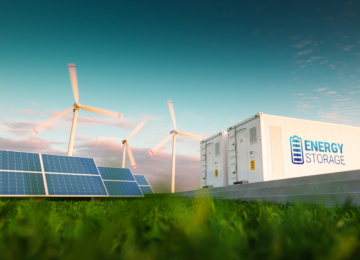The possibilities and impossibilities of batteries during power outages
The recent power outages from Spain and Portugal raise questions about the stability of the power grid, including in the Netherlands. Several articles refer to the use of energy storage, specifically batteries[1], as a possible solution to prevent power outages.
Regardless of the specific situation of power outages in Spain and Portugal - the cause of which is currently under investigation - the possibility of power outages is an increasing risk. In this article, we set out what role batteries can and cannot (yet) play in preventing power outages in the Netherlands.
Chance of power outages in the Netherlands
The likelihood of a large-scale power outage could also occur in the Netherlands, according to TenneT. One reason for this is the transition to a fully sustainable energy system. The future system will require new and different shock absorbers to keep the grid stable. TenneT expects that in the period after 2030 the security of supply standard, which is exceptionally high in the Netherlands with a reliability of 99.9996%, could be jeopardized. TenneT examines this annually via the Security of Supply Monitoring Report. Flexible power - such as batteries - will be able to play an important role in ensuring security of supply. Although TenneT does not make any pronouncements on how many batteries are needed for this purpose, they explicitly monitor the development of the amount of battery power in the Monitoring Report in order to measure the consequences for the security of supply standard. As such, batteries are seen as one of the important options for monitoring the security of supply in the short term and thus keeping the electricity system afloat.
Role of batteries in power failure: preventing and restarting
Batteries can play an important role in power outages in two ways. On the one hand, batteries can prevent the possibility of power outages by providing grid stabilization services and, on the other hand, if power outages do occur, they can help to quickly restart the system.
By storing or delivering energy at the right location at the right times when there is an unexpected peak demand for electricity or, conversely, when there is an unexpected drop in electricity supply, batteries can keep the system in balance at milliseconds. This prevents failures at the local level that can lead to problems at the regional and even national level via a domino effect.
Should power outages do occur that batteries can also (potentially) play an important role in restarting the grid. In fact, batteries can be "grid-forming" via an additional software. Batteries using this software are so designed to provide emergency power during power outages and to integrate renewable energy sources into the grid. One of the key functions in this regard is 'island-mode,' where electricity continues to be supplied from the battery while in the surrounding area the grid voltage is down due to a power outage. Another function is "black start," where batteries continue to feed the grid in part when the rest of the grid fails. There are other grid-forming services that batteries can provide, such as 'inertia,' which organizes artificial delays in the system, providing immediate backup power[2].
Is potential of batteries in power outages being exploited now?
There are already batteries today that offer grid-forming functions. For example, mobile batteries can continue to operate independently in island mode, and batteries used as backup can serve as emergency power supplies for hospitals, for example, ensuring continuity of essential services. New home battery models are also coming to market that automatically become a home's power source when the grid fails.
Nevertheless, most of today's batteries, from home storage to utility scale, do not yet have the grid-forming software. This means that when the power grid goes down, so does the battery (incidentally, this is now true of most conventional power plants). This is because grid-forming software increases the price of the battery with no specific market currently in place to recover this cost. This is expected to change as we move toward a fully renewable energy system, with large uncertainties due to weather dependencies.
It is also for this reason that the European Commission is pushing for the functionality of grid shaping software. For example, the European Agency for Energy Regulators (ACER) has started work, on behalf of the European Commission, on modifications to Grid Codes to allow generation units larger than 10 MW connected at (ultra)high voltage level, or directly to an MS/HS transformer substation, to provide grid shaping support to the grid. The implementation period has been set at three years after publication (expected 2025).
What needs to be done?
Batteries can potentially play an important role in partially preventing and restarting the grid during power outages. What is needed to do this?
First, it is crucial that the amount of battery storage increases in the Netherlands. Anno 2025 we are not yet at 1 GW of battery power. This while grid operators assume that by 2050 a maximum of 70 GW[3] to battery power in the energy system will stand. With the rapid development of wind and solar in the system and the planned phase-out of gas and coal-fired power plants in the near term, an acceleration of batteries - as well as for heat and molecule storage - is necessary to keep the system in balance. Although more battery projects are being announced, ESNL sees it as unrealistic that through current policies we are moving toward dozens of gigawatts that grid operators say would already be in the system in the short term.
It is therefore important to have a better national understanding of the amount of energy storage required in a fully sustainable energy system and to implement policies accordingly. This by, for example, determining in which strategic locations battery storage should be placed so that risks and dependencies are reduced. This should include how to improve the financial position of batteries. At present, the lack of a profitable business case - mainly due to the high transport tariffs - is preventing the acceleration of storage in the Netherlands, even though these systems are of great social importance.
ESNL is also in favor of developing a capacity mechanism. A capacity mechanism is a measure that ensures that the supply and demand of electricity can be balanced at any time to guarantee security of supply and prevent power outages. Surrounding countries have already introduced a capacity mechanism, the Netherlands has not yet. ESNL urges that the design principles of a capacity mechanism be developed so that this mechanism is at least on the shelf, should it become necessary.
As stated, at the European level the use of grid-forming software is being driven, regulations must be adapted so that batteries can provide these new services. Energy Storage NL is happy to enter into discussions with grid operators and the ministry to see what steps are necessary to accelerate the enabling of this software.
[1] www.bloomberg.com/opinion/articles/2025-04-30/spanish-blackout-shouldn-t-trigger-a-green-retreat
[2] www.energystoragenl.nl/2024/09/09/rwe-bouwt-ultrasnel-innovatief-batterijopslagsysteem-in-nederland-voor-netstabilisatie/
[3] www.netbeheernederland.nl/publicatie/rapport-ii3050-scenarios





